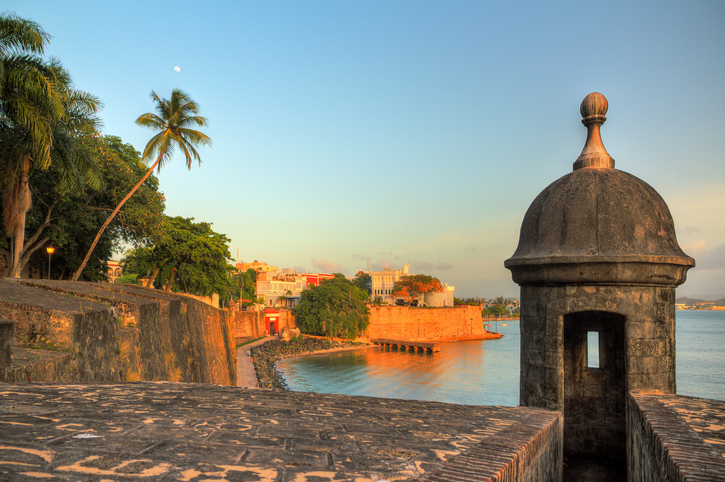You could describe San Juan as a sprawling metropolis with an identity crisis. Large parts of the Puerto Rican capital feel as if they belong in North America. That’s no surprise, as the island has been a Commonwealth of the USA since the 1898 Spanish-American War resulted in a parting of the ways between Puerto Rico and the Spanish Empire. But head into Old San Juan, and the Hispanic influence dominates. This colourful walled city exudes charm and for many is a highlight of their stay on the island.
The compact old town is easily explored in a day, and many of those who visit do just that, returning to their cruise ships in the conveniently situated port in time to set sail into the sunset. But the cobbled streets and colonial architecture reward those who give it more time. Once you’ve ticked off the sights, there’s a lot of pleasure to be found in simply wandering aimlessly without much of a plan at all.
A city packed full of history
That’s not to say there aren’t plenty of sights to explore. The city has not one but two imposing fortresses, their thick stone walls designed to defend against attack. Fuerte San Felipe del Morro, located at the western tip of the city, dominates a headland overlooking the Atlantic. Dating back to 1539, this could be the oldest Spanish fort in the New World. Today visitors can explore the multi-level fort, with its museum and lighthouse.
Across town, linked by a tourist “train”, the smaller Castillo de San Cristobal played a different role, defending the city from the interior rather than from maritime marauders. It’s much younger than El Morro, dating from 1783, but in its cells you’ll spot some fascinating historic graffiti. The Cuartel de Ballaja, once a military barracks for Spanish soldiers, now houses the Museum of the Americas.

The city’s cathedral is also of interest: construction began in 1521 and parts of the original ceiling and staircase remain. At the side of the cathedral stands a marble tomb, a memorial to Juan Ponce de Leon. This formidable Spanish conquistador was the first governor of Puerto Rico before setting off to lead the first known expedition to Florida to the north. His body was interred for over three centuries in the Iglesia de San José, the second oldest church in the Americas, before being moved. Completing the Ponce de Leon collection is La Casa Blanca, home to his family for 200 or so years.
Relax under the Caribbean sun
Near to the Puerta de San Juan, seek out La Fortaleza. Set behind huge iron gates, it was built in 1533 and is the oldest executive mansion in continuous use not just on the island, but in the whole of the western hemisphere. The governor’s home is also known as the Palacio de Santa Catalina; its pretty blue and white façade is beautiful under the Caribbean sun. In some of the streets nearby, you’ll notice the cobbles have a distinctly blue appearance. What look like granite setts are in fact blocks of compacted slag. Known as adoquines, they were used as ballast to weigh down the ships that docked here in the 18th century.
But Old San Juan is much more than a living museum. By day, people chatter at pavement café tables and dine late into the night in its many excellent restaurants. Fortaleza Street is the place to experience a fusion of Caribbean and international cuisine. Try mofongo, made from mashed plantains and often topped with shrimp or served with chicken. Old San Juan also has a lively bar and live music scene; its salsa clubs and discos draw night owls who dance until the small hours. And if you overdo it, there are even a couple of beaches fringed with palms to provide shade while you take a restorative siesta. This quaint little corner of the nation’s capital really does have it all.

